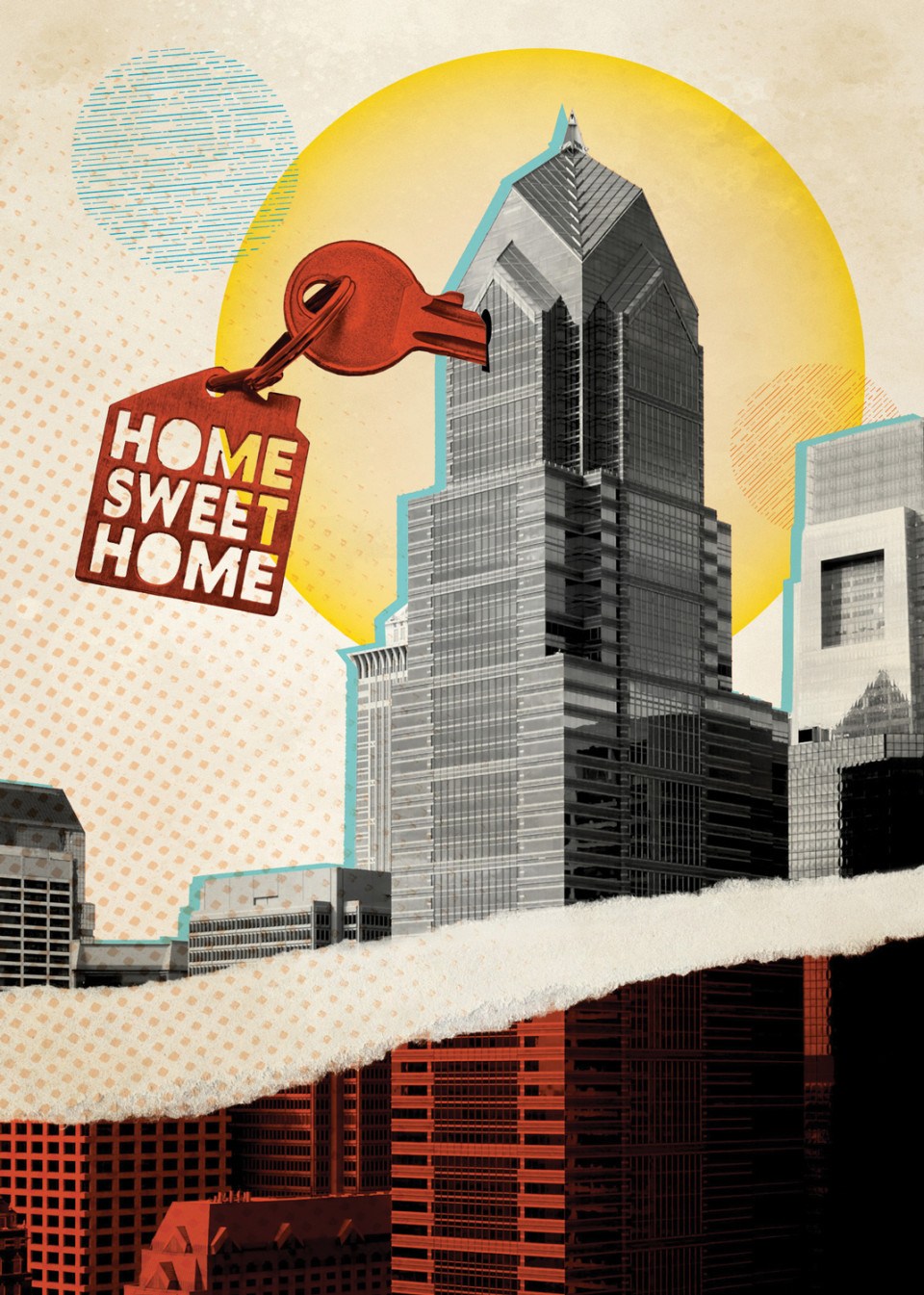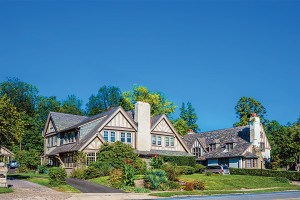What Will Become of Philly’s Vacant Office Space?
Many workers still haven’t returned to their downtown offices. How we fill those high-rises will affect Center City forever.

Working from home has created vacant office space in Center City. Now what? / Photo-Illustration by Leticia R. Albano
Dropped by your office lately? I haven’t. This magazine gave up its offices on Washington Square in January of this year. And Philly Mag may be on the cutting edge of a trend, if some reports are to be believed.
Even as some of Center City’s biggest employers, most notably Comcast, have told staffers they must return to the office at least three days a week, lots of other employers have remained largely or totally remote since March 2020.
Such employers have contributed to a falloff in office occupancy in Center City — one that made the national radar in September, when the Wall Street Journal dubbed Philly “The City Where People Aren’t Going Back to Offices.”
The Journal drew its conclusions using information from Kastle Systems, a company that makes office entry technology. Kastle’s card-swipe data suggested Philly’s office occupancy rate was just 40 percent — and even less during some weeks this past summer. According to Kastle, only Silicon Valley techies go to the office less.
If the data is accurate, that would mean lots of empty desks and unused space. Center City District president and CEO Paul Levy says the data is definitely not accurate. He has pointed out in several places, including in that Journal article, that data the CCD collects paints a somewhat different story. (He’s also suggested that Kastle monitors no more than two buildings in Philly’s office market.) Using sensors on the street and mobile phone data, Levy and the CCD put the occupancy figure at closer to 60 percent — 57, to be precise, in June. And by September, they say, workers of all kinds in Center City were back at 78 percent of pre-pandemic levels, while office workers on West Market and JFK were back at 58 percent.
But even the higher figure means that lots of space is sitting empty three and a half years after the pandemic started. Clint Randall, head of the research group at commercial real estate company JLL, says the 57 percent occupancy figure means that 40 percent of all the office space in Center City in underutilized.
According to figures supplied by JLL, Center City contains more than 42.7 million square feet of office space right now. If that’s the case, that 40 percent underused figure works out to a pretty hefty 17 million square feet, or a little more than 14 One Liberty Places. Depending on when you go, Center City can feel bustling. But on other days, it can seem downright canyon-esque — four-day workweek, anyone? It’s led to a drop-off in lunch business at the restaurants that remain downtown and a general sense that things aren’t ever quite going back to, you know, the way they used to be.
The Center City District has dutifully reported the steady build-back from zero occupancy. But you get the sense that at some point, and maybe this is it, things may plateau on the back-to-work front. If so, what will become of this unused space?
If our current level of office occupancy is, indeed, the new normal, will we be left with a bunch of see-through towers dotting our skyline?
Not freakin’ likely, says Levy. As he pointed out in an essay for the Philadelphia Citizen in August, “Forty office towers downtown, almost 10 million square feet, were converted to housing between 1998 and 2022” — at the same time that new office space was being built. And commercial property owners continue to get a 90 percent tax abatement on the value of reconstruction projects for a full 10 years, which should serve as an incentive for owners of old office buildings to turn them into apartments or condos — or sell them to someone who will.
So at least some of the space could certainly become residential. But how much — and how soon?
“The odds that all of the empty or underutilized office space becomes apartments is zero,” says Leonard Klehr, vice chair of Lubert-Adler Real Estate Funds. “There will be a small handful of buildings in the central business district that get converted. Most of the buildings just don’t work as apartments.”
Klehr should know. Lubert-Adler exclusively renovates older buildings — its transformation of an old PECO station into the Battery apartments has been stunning, and currently, it’s got plans for Broad Street’s iconic Bellevue. Over the more than 25 years it’s been in existence, the firm has acquired and rehabbed more than 700 buildings in cities from coast to coast, pouring nearly $5.9 billion into renewing them. That figure includes 26 office buildings in Philadelphia with some eight million square feet of space.
Co-founder and CEO Dean Adler says that to work as residences, an office building must clear three hurdles.
The first is age. “The building should be at least 50 or 60 years old, so you can qualify for historic tax credits,” he says. Buildings that receive those credits can get 20 percent of their renovation costs rebated — “a huge savings,” Adler notes.
Next, those conversions work better where those historic buildings have company — what Adler calls “historic infrastructure,” and by that, he doesn’t mean crumbling roads and ancient sewers, but rather, neighboring buildings of a certain age. “For example, Philadelphia has historic residential infrastructure in the city. Boston does. New York does. Washington does. But a lot of the cities in the southwest — Dallas, Houston — they don’t have these historic buildings.”
The third ingredient for a successful office-to-residential conversion is activity on the street. “You want to make sure the building is in the part of the city where there’s walkability for at least 18 hours a day,” Adler says. “People leave their apartments at six o’clock at night and want to go out for dinner, or they want to meet people.” Adler says buildings in districts like the West Market Street office canyon might make less-than-ideal conversion candidates, since the streets there — at present, anyway — go quiet after “office” hours.
“You’re in the middle of nowhere,” he says of residents of a converted office-district building. “You may want to go further out, where industrial buildings were converted. There’s restaurants, there’s galleries there.”
And yet, if you look at it a little bit differently, those buildings in office districts might make good candidates for residential conversion after all.
The industrial buildings Adler refers to had also been abandoned, many for years, when developers descended on them and began turning them into loft apartment buildings. Old City gained new life through such conversions. We have an entire residential neighborhood that didn’t exist before — Callowhill — thanks to all the industrial buildings that were converted there starting in the late ’90s.
If Callowhill could be transformed from empty quarter to lively neighborhood, then perhaps so could Market Street West. The seeds have already been planted in the form of two residential towers, 1919 Market and the Murano. And PMC Property Group turned the former Keystone AAA headquarters at 2040 Market Street into apartments in 2012.
Another conversion along West Market is in the works: Alterra Property Group acquired 1701 Market earlier this year and has plans to convert it into 325 apartments with ground-floor retail.
This project actually checks off at least two of Adler’s boxes. The 1701 Market building, most recently home to the Morgan Lewis law firm, was built as Six Penn Center in 1956, so it crosses the historic threshold. Two other nearby office buildings now contain residences: the Phoenix, the former INA headquarters at 16th and Arch streets, and the upper floors of Two Liberty Place.
The 18-hour street activity hasn’t arrived at 17th and Market yet, but with places like Victory Brewing Company, Urban Farmer, Harper’s Garden, the seasonal Uptown Beer Garden, Tir Na Nóg and Misconduct Tavern within a few-block radius, the foundation for that 18-hour district has been laid. And at 1701 Market, Alterra is working to lure more restaurant and retail tenants.
So it may be that some not-so-historic West Market buildings might get converted even if they don’t clear all of Adler’s hurdles. But many others will not. What will happen to those empty and underutilized buildings?
“That’s the trillion-dollar question,” says Alterra Property Group founder and managing partner Leo Addimando. “I don’t have an answer to it, and the banks who hold loans on these buildings don’t, either. I don’t think we’ll see 50 percent of those buildings remain vacant, as some prognosticators who don’t know how the real estate market works predict. But we may have to wait some time before we find out just how many fill again.”
If you’re looking for silver linings, people are returning to work, or at least (perhaps) more than recent news stories suggest. Demand for living space in Center City remains strong — look no further than the wave of new downtown apartment projects over the past few years — due in part to the sizable ranks of people who now work fully remotely yet wish to live in what’s still the liveliest part of the city. And the Center City District has launched programming designed to both appeal to those remote workers and encourage office workers to come back. On top of that, SEPTA this year rolled out new programs whereby employers could purchase steeply discounted passes for their employees.
That still ultimately leaves a big chunk of uncertainty, which we know markets, real estate and otherwise, detest. Will the right combination of conversions and steadily increasing return to work strike a new sustainable equilibrium? Lauren Gilchrist, executive vice president and market leader at Newmark, says we might be close to one already. The so-called “trophy” buildings and other first-class office space should remain fully occupied, and, she says, “Nine million square feet of obsolete office space has already been converted to residential uses.”
Many of the buildings that remain don’t make good conversion candidates, and if occupancy in those buildings falls, lenders and owners may try to repackage loans so owners can afford the payments (and lower office rents). And if worse comes to worst, some of those old, obsolete buildings may simply be replaced by new ones down the road.
Quite likely, those will have residences in them. And many of their residents will be working from home. So, a return to office of a different stripe.
Published as “The Office Is Closed” in the November 2023 issue of Philadelphia magazine.


